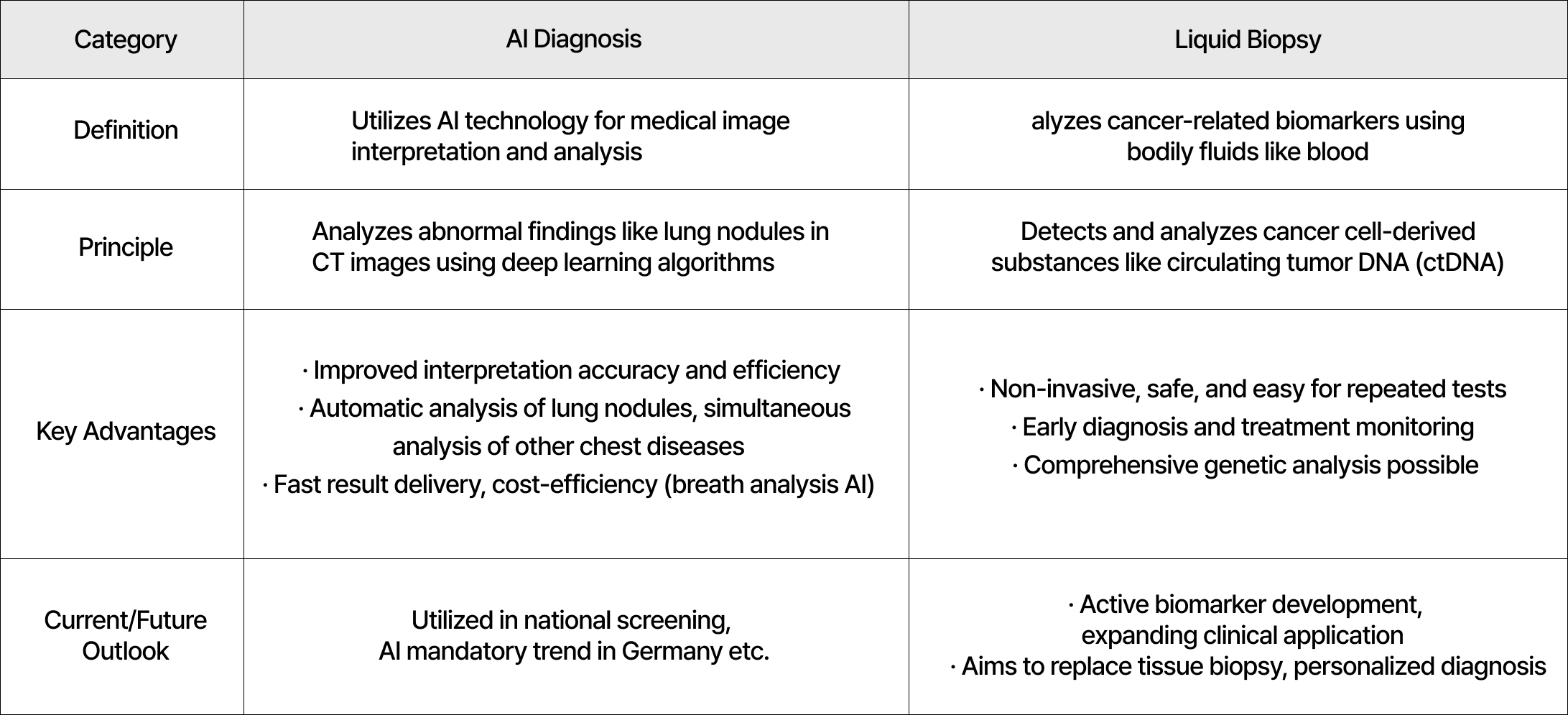Lung cancer remains the deadliest cancer worldwide, with the importance of early detection constantly emphasized. However, existing diagnostic methods have limitations such as high costs, radiation exposure, and difficulty in early-stage application. To overcome these limitations and further increase the early detection rate of lung cancer, cutting-edge technologies like artificial intelligence (AI) and liquid biopsy are rapidly advancing, transforming the future of lung cancer diagnosis and management.
Limitations of Existing Diagnostic Methods and the New Necessity
Lung cancer often presents with no distinct symptoms until it is discovered, making it difficult for patients to easily recognize the disease. While conventional diagnostic methods such as chest X-rays, low-dose CT (LDCT), and positron emission tomography (PET) are essential for lung cancer diagnosis, they have limitations: they are costly and involve radiation exposure, making repeated examinations difficult. Furthermore, applying existing diagnostic methods in the early stages of lung cancer has also been a challenge. As an alternative to address these issues, the introduction of molecular-level fluid analysis (liquid biopsy) and artificial intelligence (AI) technologies is being actively researched.
AI-Based Lung Cancer Diagnosis
Artificial intelligence (AI) technology is playing an innovative role in enhancing the accuracy and efficiency of lung cancer screening CT image interpretation. AI is evolving into an integrated diagnostic system that can automatically analyze lung nodules, reducing the interpretation burden on medical staff, and simultaneously analyze other chest diseases like chronic obstructive pulmonary disease (COPD) and coronary artery calcification with a single CT scan. The adoption of such AI-based diagnostic solutions is a global trend. Germany, for instance, has announced ordinances mandating or strongly encouraging the use of AI in medical image interpretation for its national lung cancer screening program, indicating rapid discussions on AI utilization.
Liquid Biopsy Technology
Liquid biopsy is an innovative diagnostic method that uses patient bodily fluids such as blood, cerebrospinal fluid, and pleural fluid to diagnose cancer and monitor treatment effectiveness. It detects and analyzes circulating tumor DNA (ctDNA) – DNA fragments shed by cancer cells into the bloodstream – to identify genetic mutations, thereby diagnosing cancer and assessing its progression.
The main advantages of liquid biopsy are as follows:
- Simple and Safe: Compared to tissue biopsy, which involves surgically removing cancer tissue, liquid biopsy carries less risk of infection or internal bleeding and allows for easy, repeated testing, making continuous monitoring convenient. It is particularly useful for elderly patients or those for whom invasive procedures are difficult.
- Early Diagnosis and Monitoring: It suggests the possibility of rapid lung cancer diagnosis through basic blood tests for asymptomatic individuals , and can be used to identify resistance genes during chemotherapy or for early detection of recurrence after cancer surgery.
- Comprehensive Analysis: A single blood draw allows for comprehensive genetic analysis, and it is particularly useful for patients with metastatic or advanced cancer where tissue biopsy is difficult or impossible, leading to increasing demand in the medical field.
Future Outlook: Towards Integrated and Personalized Screening
The emergence of AI and liquid biopsy is shifting the paradigm of lung cancer diagnosis from a passive approach, relying on LDCT screening for symptomatic or high-risk individuals, to an active, preventive approach that predicts and continuously monitors without symptoms. This is a fundamental movement that goes beyond simply increasing diagnostic rates, transforming the entire paradigm of lung cancer management. These technologies will enable more accurate and efficient early detection, contributing to the implementation of a patient-centered healthcare environment through the development of personalized screening algorithms and the transition to remote and home-based testing solutions. Furthermore, the integration of big data analytics can provide crucial insights for improving patient management and treatment pathways.
However, the emergence of such innovative medical technologies is not merely a technical success; it demonstrates that legal, ethical, and institutional discussions must accompany their safe and effective integration into social systems. For example, although liquid biopsy technology has completed clinical development, it must undergo KFDA approval and new medical technology certification procedures before it can be used in all medical institutions. In the case of AI, ethical considerations such as data bias, liability for interpretation errors, and the impact of false positive/negative results for liquid biopsy on patients are necessary. This suggests that a balance between the pace of technological advancement and societal acceptance and regulatory systems is crucial.
Comparison of Next-Generation Lung Cancer Diagnostic Technologies

Lung cancer screening is now moving beyond mere 'detection' towards an era of prediction, prevention, and precise management. AI and liquid biopsy are no longer 'stories of the future.' They are already being progressively utilized in clinical settings, opening up possibilities as proactive health management tools not only for high-risk groups but also for the general population. The future of lung cancer screening will be a technology that transforms the lives of individual patients more quickly, more accurately, and with less burden.


 List
List


